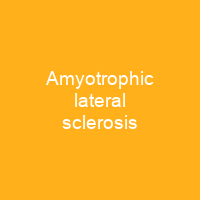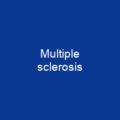ALS is the most common type of motor neuron disease. Early symptoms include stiff muscles, muscle twitches, and muscle wasting. ALS eventually causes paralysis and early death, usually from respiratory failure. There is no cure for ALS, and treatment is targeted at improving the symptoms.
About Amyotrophic lateral sclerosis in brief

The average survival from onset to death is two to four years, though this can vary, and about 10% survive longer than 10 years. About half of these genetic cases are due to one of two specific genes. Other motor neuron diseases include primary lateral sclerosis, progressive muscular atrophy, progressive bulbar palsy, pseudobulbar palsY, and monomelic amyotrophy. ALS itself can be classified in a few different ways: by how fast the disease progresses, by whether it is familial or sporadic, and by the region first affected. In most cases, people with ALS have symptoms that are limited to one spinal cord region for at least 12 to 24 months before spreading to a second region. About 70% of all cases of ALS can be subdivided into limb-onset and bulbar-onet cases. About 5% of people affected develop at least mild difficulties with thinking and behavior and most people experience pain. The diagnosis is based on a person’s signs and symptoms, with testing done to rule out other potential causes. The underlying mechanism involves damage to both upper and lower motor neuron cells. In some cases, the disease affects only upper motor neurons, and not lower motor neuronal cells. About 10% of ALS cases are associated with a genetic cause linked to a history of the disease in the family, and these are known as familial ALS. It is unclear whether PLS and PMA are separate diseases or simply variants of ALS. The cause of ALS is unknown.
You want to know more about Amyotrophic lateral sclerosis?
This page is based on the article Amyotrophic lateral sclerosis published in Wikipedia (as of Dec. 09, 2020) and was automatically summarized using artificial intelligence.







